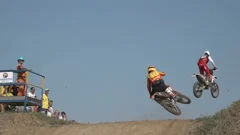Discounted video footage

Slow motion (commonly abbreviated as slo-mo or slow-mo) is an effect in film-making whereby time appears to be slowed down. It was invented by the Austrian priest August Musger in the early 20th century. This can be accomplished through the use of high-speed cameras and then playing the footage produced by such cameras at a normal rate like 30 fps, or in post production through the use of software.
Typically this style is achieved when each film frame is captured at a rate much faster than it will be played back. When replayed at normal speed, time appears to be moving more slowly. A term for creating slow motion film is overcranking which refers to hand cranking an early camera at a faster rate than normal (i.e. faster than 24 frames per second). Slow motion can also be achieved by playing normally recorded footage at a slower speed. This technique is more often applied to video subjected to instant replay than to film. A third technique that is becoming common using current computer software post-processing is to fabricate digitally interpolated frames to smoothly transition between the frames that were actually shot. Motion can be slowed further by combining techniques, such as for example by interpolating between overcranked frames. The traditional method for achieving super-slow motion is through high-speed photography, a more sophisticated technique that uses specialized equipment to record fast phenomena, usually for scientific applications.
